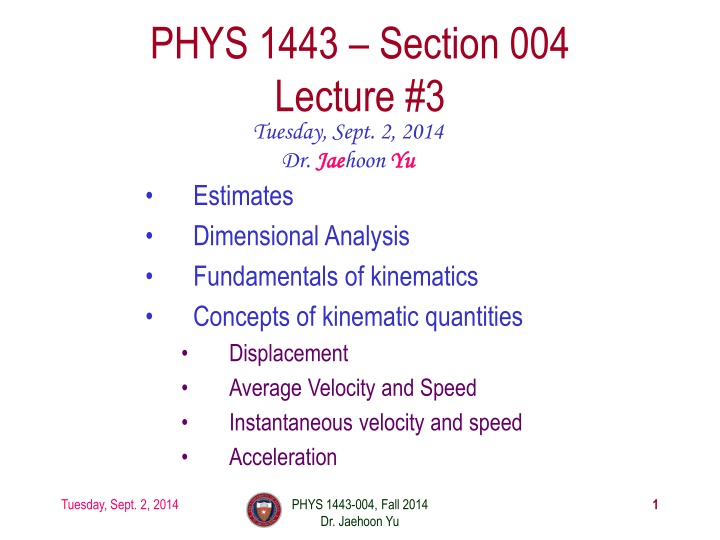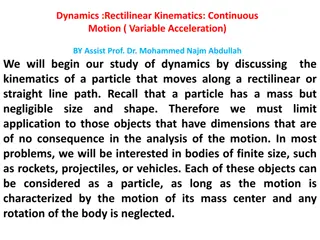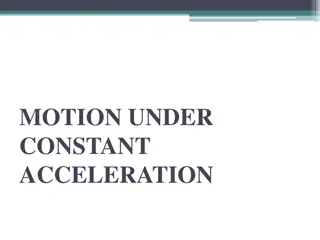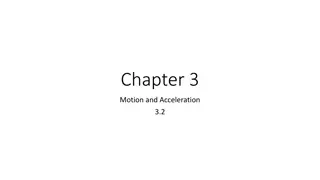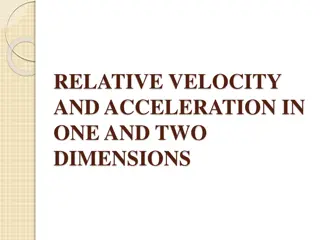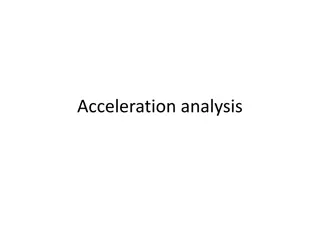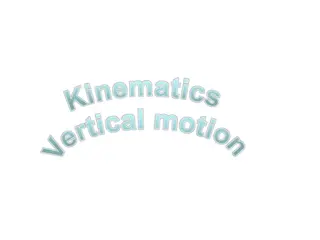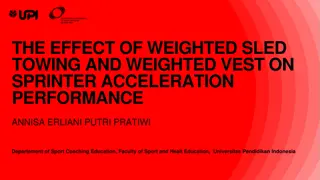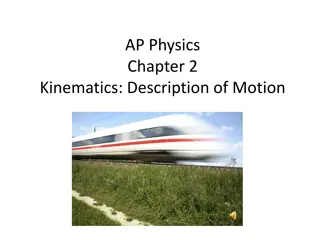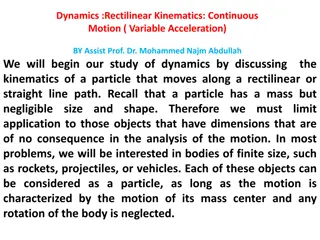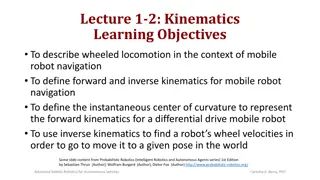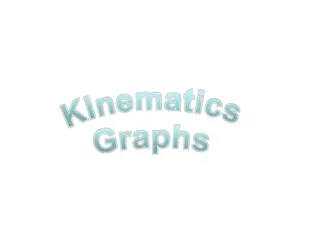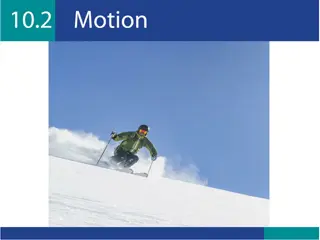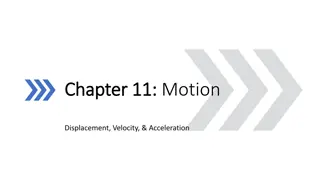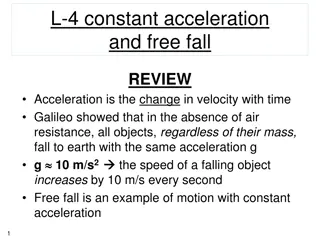Fundamentals of Kinematics: Displacement, Velocity, Acceleration
In this lecture, Dr. Jaehoon Yu covers the essentials of kinematics, including concepts of displacement, average velocity, speed, instantaneous velocity, and acceleration. The content also discusses dimensional analysis, estimation techniques, and order-of-magnitude calculations. Additionally, there are announcements about quiz results, homework tips, and a special extra credit project related to deriving kinematic equations. An example problem involving estimating the radius of the Earth using triangulation is also presented.
Download Presentation

Please find below an Image/Link to download the presentation.
The content on the website is provided AS IS for your information and personal use only. It may not be sold, licensed, or shared on other websites without obtaining consent from the author.If you encounter any issues during the download, it is possible that the publisher has removed the file from their server.
You are allowed to download the files provided on this website for personal or commercial use, subject to the condition that they are used lawfully. All files are the property of their respective owners.
The content on the website is provided AS IS for your information and personal use only. It may not be sold, licensed, or shared on other websites without obtaining consent from the author.
E N D
Presentation Transcript
PHYS 1443 Section 004 Lecture #3 Tuesday, Sept. 2, 2014 Dr. Jae Jaehoon Yu Estimates Dimensional Analysis Fundamentals of kinematics Concepts of kinematic quantities Displacement Average Velocity and Speed Instantaneous velocity and speed Acceleration Yu Tuesday, Sept. 2, 2014 PHYS 1443-004, Fall 2014 Dr. Jaehoon Yu 1
Announcements Quiz results Class average: 41.6/58 Equivalent to 71.7/100 Top score: 57/58 Some Homework tips When inputting answers to the Quest homework system Unless the problem explicitly asks for significant figures, input as many digits as you can The Quest is dumb. So it does not know about anything other than numbers More details are http://web4.cns.utexas.edu/quest/support/student/#Num Physics department colloquium 4pm every Wednesday in SH101 Tomorrow is the faculty research expo Tuesday, Sept. 2, 2014 PHYS 1443-004, Fall 2014 Dr. Jaehoon Yu 2
Reminder: Special Project #1 for Extra Credit Find the solutions for yx2-zx+v=0 5 points X is the unknown variable, and y, z and v are constant coefficients! You cannot just plug into the quadratic equations! You must show a complete algebraic process of obtaining the solutions! Derive the kinematic equation from first principles and the known kinematic equations 10 points You must show your OWN work in detail to obtain the full credit Must be in much more detail than in this lecture note!!! Please do not copy from the lecture note or from your friends. You will all get 0! ( ) = + 2 v v a x x 2 2 0 0 Tuesday, Sept. 2, 2014 Due Thursday, Sept. 4 PHYS 1443-004, Fall 2014 Dr. Jaehoon Yu 4
Estimates & Order-of-Magnitude Calculations Estimate = Approximation Useful for rough calculations to determine the necessity of higher precision Usually done under certain assumptions Might require modification of assumptions, if higher precision is necessary Order of magnitude estimate: Estimates done to the precision of 10s or exponents of 10s; Three orders of magnitude: 103=1,000 Round up for Order of magnitude estimate; 8x107 ~ 108 Similar terms: Ball-park-figures , guesstimates , etc Tuesday, Sept. 2, 2014 PHYS 1443-004, Fall 2014 Dr. Jaehoon Yu 5 5
Example for Estimates Estimate the radius of the Earth using triangulation as shown in the picture when d=4.4km and h=1.5m. Pythagorian theorem ( R Solving for R ) hR h 2 + + + 2 2 R h d + R D=4.4km + 2 2 2 2 2 d R R 2 2 d h R 2 h ( 2- 1.5m ( 2 1.5m ) ) 2 4400m = = 6500km Real R=6380km Tuesday, Sept. 2, 2014 PHYS 1443-004, Fall 2014 Dr. Jaehoon Yu 6 6
Dimensions of Units and Dimensional Analysis An extremely useful concept in solving physical problems Good to write physical laws in mathematical expressions No matter what units are used the base quantities are the same Length Length (distance) is length whether meter or inch is used to express the size: Usually denoted as [L] The same is true for Mass ([ Mass ([M]) M])and Time ([T]) One can say Dimension of Length, Mass or Time Dimensions are treated as algebraic quantities: Can perform two algebraic operations; multiplication or division [L] Time ([T]) Tuesday, Sept. 2, 2014 PHYS 1443-004, Fall 2014 Dr. Jaehoon Yu 7 7
Dimensions of units and Dimensional Analysis cnt d One can use dimensions only to check the validity of one s expression: Dimensional analysis Eg: Speed [v] = [L]/[T]=[L][T-1] Distance (L) traveled by a car running at the speed V in time T L = V*T = [L/T]*[T]=[L] More general expression of dimensional analysis is using exponents: eg. [v]=[LnTm] =[L][T-1] where n = 1 and m = -1 Tuesday, Sept. 2, 2014 PHYS 1443-004, Fall 2014 Dr. Jaehoon Yu 8 8
Examples Show that the expression [v] = [at] is dimensionally correct Speed: [v] =[L]/[T] Acceleration: [a] =[L]/[T]2 Thus, [at] = (L/T2)xT=LT(-2+1) =LT-1 =[L]/[T]= [v] Suppose the acceleration a of a circularly moving particle with speed v and radius r is proportional to rn and vm. What are n andm? a a m n L n+ = 1 2 ( ) L r r v v LT = + 1 2 = n m L m T T = = 2 = m + a = nv m m m 2 2 kr = n m n n 1 1 Dimensionless constant Length Speed 2 v = = 1 2 a kr v r Tuesday, Sept. 2, 2014 PHYS 1443-004, Fall 2014 Dr. Jaehoon Yu 9 9
Some Fundamentals Kinematics: Description of Motion without understanding the cause of the motion Dynamics: Description of motion accompanied with understanding the cause of the motion Vector and Scalar quantities: Scalar: Physical quantities that require magnitude but no direction Speed, length, mass, height, volume, area, magnitude of a vector quantity, etc Vector: Physical quantities that require both magnitude and direction Velocity, Acceleration, Force, Momentum It does not make sense to say I ran with velocity of 10miles/hour. Objects can be treated as point-like if their sizes are smaller than the scale in the problem Earth can be treated as a point like object (or a particle)in celestial problems Simplification of the problem (The first step in setting up to solve a problem ) Any other examples? Tuesday, Sept. 2, 2014 PHYS 1443-004, Fall 2014 Dr. Jaehoon Yu 10 10
Some More Fundamentals Motions: Can be described as long as the position is known at any given time (or position is expressed as a function of time) Translation: Linear motion along a line Rotation: Circular or elliptical motion Vibration: Oscillation Dimensions of geometry 0 dimension: A point 1 dimension: Linear drag of a point, resulting in a line Motion in one-dimension is a motion on a line 2 dimension: Linear drag of a line resulting in a surface 3 dimension: Perpendicular Linear drag of a surface, resulting in a stereo object Tuesday, Sept. 2, 2014 PHYS 1443-004, Fall 2014 Dr. Jaehoon Yu 11 11
Displacement, Velocity and Speed One dimensional displacement is defined as: x x Displacement is the difference between initial and final poisitions of the motion and is a vector quantity. How is this different than distance? Unit? m f i x A vector quantity x t x t x t i Displacement Elapsed Time vx-avg The average velocity is defined as: Unit? m/s f = i A vector quantity f Displacement per unit time in the interval throughout the motion vavg Total Distance Traveled Total Elapsed Time The average speed is defined as: m/s Unit? A scalar quantity Can someone tell me what the difference between speed and velocity is? Tuesday, Sept. 2, 2014 PHYS 1443-004, Fall 2014 Dr. Jaehoon Yu 12
1 x 2 x x - x = x What is the displacement? 1 2 vx-avg= - t t t= How much is the elapsed time? 0 Dx Dt Dx Dt x2- x1 t -t0 = What is the average velocity? x2- x1 t -t0 vavg= = What is the average speed? Tuesday, Sept. 2, 2014 PHYS 1443-004, Fall 2014 Dr. Jaehoon Yu 13
Difference between Speed and Velocity Let s take a simple one dimensional translational motion that has many segments: Let s call this line as X-axis Let s have a couple of motions in a total time interval of 20 sec. +15m +5m +10m -5m Total Displacement: -10m -15m xf - xi = = x x 0( ) m x x t i i x t 0 20 x t Average Velocity: i = f = = 0( / ) m s v x i f 10 15 5 15 10 5 60( ) + + + + + = 60 20 Total Distance Traveled: D= m vavg Total Distance Traveled Total Time Interval Average Speed: = = 3( / ) m s Tuesday, Sept. 2, 2014 PHYS 1443-004, Fall 2014 Dr. Jaehoon Yu 14 14
Example The position of a runner as a function of time is plotted as moving along the x axis of a coordinate system. During a 3.00-s time interval, the runner s position changes from x1=50.0m to x2=30.5 m, as shown in the figure. What was the runner s average velocity? What was the average speed? Displacement: 19.5( ) = = 30.5 50.0 = x x x x x m i f 2 1 Average Velocity: x x t t Average Speed: Total Distance Traveled Total Time Interval 50.0 30.5 3.00 19.5 3.00 x t x t x t i f = = = 6.50( / ) = v 2 1 m s x i f 2 1 v + 19.5 3.00 = = 6.50( / ) = + m s Tuesday, Sept. 2, 2014 PHYS 1443-004, Fall 2014 Dr. Jaehoon Yu 15 15
Example of a segmented motion You drive a beat-up pickup truck along a straight road for 8.4km at 70km/h, at which point the truck runs out of gasoline and stops. Over the next 30min, you walk another 2.0km farther along the road to a gas station. (a) what is your overall displacement from the beginning of your drive to your arrival at the station? You can split this motion in two segments Segment 1: from the start to the point where the truck ran out of gas, x1 Dx1 xf -xi = +8.4km Segment 2: from the point where you started walking to the gas station, x2 Dx2 xf -xi = Overall displacement x is Dx = +2.0km ( )=10.4 km =10400 m ( ) ( ) Dx1+Dx2=+8.4+ +2.0 Tuesday, Sept. 2, 2014 PHYS 1443-004, Fall 2014 Dr. Jaehoon Yu 16 16
Example You drive a beat-up pickup truck along a straight road for 8.4km at 70km/h, at which point the truck runs out of gasoline and stops. Over the next 30min, you walk another 2.0km farther along the road to a gas station. (b) What is the time interval t from the beginning of your drive to your arrival at the station? Figure out the time interval in each segments of the motion and add them together. We know what the interval for the second segment is: t2=30min What is the interval for the first segment, t1? Use the definition of average velocity and solve it for t1 vx1=Dx1 Dt1 Add the two time intervals for Dt = Dt1+Dt2= 7.2+30=37 min Dx1 vx1 ( )= 7.2 min ( ) 8.4 70=0.12 hr Dt1= = ( ) =37 60= 2200 s ( ) Tuesday, Sept. 2, 2014 total time interval t PHYS 1443-004, Fall 2014 Dr. Jaehoon Yu 17 17
Example You drive a beat-up pickup truck along a straight road for 8.4km at 70km/h, at which point the truck runs out of gasoline and stops. Over the next 30min, you walk another 2.0km farther along the road to a gas station. (c) What is your average velocity vavg from the beginning of your drive to your arrival at the station? Using the definition of the average velocity, just simply divide the overall displacement by the overall time interval: Dx1+Dx1 Dt1+Dt1 What is the average speed? What is the average velocity and average speed in km/h? ( ) ) 10400 m ( ) 2200 s ( ) 10.4 km 37 min ( Dx Dt= ( ) vx= = = =4.7 m s Tuesday, Sept. 2, 2014 PHYS 1443-004, Fall 2014 Dr. Jaehoon Yu 18 18
Instantaneous Velocity and Speed Can average quantities tell you the detailed story of the whole motion? Instantaneous velocity is defined as: What does this mean? Displacement in an infinitesimal time interval Average velocity over a very, very short amount of time NO!! Instantaneous speed is the size (magnitude) of the velocity vector: *Magnitude of Vectors are Expressed in absolute values Tuesday, Sept. 2, 2014 PHYS 1443-004, Fall 2014 Dr. Jaehoon Yu 19
Instantaneous Velocity Instantaneous Velocity Average Velocity Time Tuesday, Sept. 2, 2014 PHYS 1443-004, Fall 2014 Dr. Jaehoon Yu 20 20 20
Position vs Time Plot Position It is helpful to understand motions to draw them on position vs time plots. x1 2 3 1 x=0 time t=0 t1 t2 t3 1. Running at a constant velocity (go from x=0 to x=x1 in t1, Displacement is + x1 in t1 time interval) Velocity is 0 (go from x1 to x1 no matter how much time changes) Running at a constant velocity but in the reverse direction as 1. (go from x1 to x=0 in t3-t2 time interval, Displacement is - x1 in t3-t2 time interval) Does this motion physically make sense? 2. 3. Tuesday, Sept. 2, 2014 PHYS 1443-004, Fall 2014 Dr. Jaehoon Yu 21 21 21
Tuesday, Sept. 2, 2014 PHYS 1443-004, Fall 2014 Dr. Jaehoon Yu 22
Example A jet engine moves along a track. Its position as a function of time is given by the equation x=At2+B where A=2.10m/s2 and B=2.80m. (a) Determine the displacement of the engine during the interval from t1=3.00s to t2=5.00s. = 2.10 (3.00) 2.80 21.7m + = 2x = = 1x = 2.10 (5.00) + = tx= tx= 2 2 2.80 55.3m 13.00 25.00 ( ) =55.3 21.7 = 33.6 m + x x Displacement is, therefore: x = 2 1 (b) Determine the average velocity during this time interval. 33.6 33.6 2.00 x t ( ) = 5.00 3.00= = x v = 16.8 / m s Tuesday, Sept. 2, 2014 PHYS 1443-004, Fall 2014 Dr. Jaehoon Yu 23 23 23
Example contd (c) Determine the instantaneous velocity at t=t2=5.00s. ( ) d d ( ) C Calculus formula for derivative and = = 1 n n 0 Ct nCt dt dt x t The derivative of the engine s equation of motion is dx dt= d dt ( ) xv = = lim t + = 2 At B 2 At 0 The instantaneous velocity at t=5.00s is ( ) ( ) = = A = 5.00 2.10 10.0 = xv t s 2 5.00 21.0 / m s Tuesday, Sept. 2, 2014 PHYS 1443-004, Fall 2014 Dr. Jaehoon Yu 24 24 24
Definitions of Displacement, Velocity and Speed f Displacement x x i x x x x i = f Average velocity v x t t t i f Total Distance Traveled Average speed v Total Time Spent x dx Instantaneous velocity = = lim t vx t dt 0 x dx Instantaneous speed = = lim t vx t dt 0 Tuesday, Sept. 2, 2014 PHYS 1443-004, Fall 2014 Dr. Jaehoon Yu 25 25 25
Acceleration Change of velocity in time (what kind of quantity is this?) Definition of the average acceleration: v v t t t Vector x v x t x t x t xi analogous to = xf i x a = f x v i i f f Definition of the instantaneous acceleration: dv dt x dx x v t = =d dx 2 d x dt analogous to x = x a = lim t t lim vx t dt 2 dt dt 0 0 In calculus terms: The slope (derivative) of the velocity vector with respect to time or the change of slopes of position as a function of time Tuesday, Sept. 2, 2014 PHYS 1443-004, Fall 2014 Dr. Jaehoon Yu 26
Acceleration vs Time Plot What does this plot tell you? Yes, you are right!! The acceleration of this motion is a constant!! Tuesday, Sept. 2, 2014 PHYS 1443-004, Fall 2014 Dr. Jaehoon Yu 27
Example A car accelerates along a straight road from rest to 75km/h in 5.0s. What is the magnitude of its average acceleration? v = 0 / m s xv t v v t 21 0 21 x a = xf t xi = xi = = = 2s ( 2 . 4 / ) m 0 . 5 0 . 5 f i = 75000 3600 m s v ( ) =21 / m s 2 2 . 4 3600 xf = = 4 2 5.4 10 ( / ) km h 1000 Tuesday, Sept. 2, 2014 PHYS 1443-004, Fall 2014 Dr. Jaehoon Yu 28
Few Confusing Things on Acceleration When an object is moving in a constant velocity (v=v0), there is no acceleration (a=0) Is there any acceleration when an object is not moving? When an object is moving faster as time goes on, (v=v(t) ), acceleration is positive (a>0). Incorrect, since the object might be moving in negative direction initially When an object is moving slower as time goes on, (v=v(t) ), acceleration is negative (a<0) Incorrect, since the object might be moving in negative direction initially In all cases, velocity is positive, unless the direction of the movement changes. Incorrect, since the object might be moving in negative direction initially Is there acceleration if an object moves in a constant speed but changes direction? The answer is YES!! Tuesday, Sept. 2, 2014 PHYS 1443-004, Fall 2014 Dr. Jaehoon Yu 29
